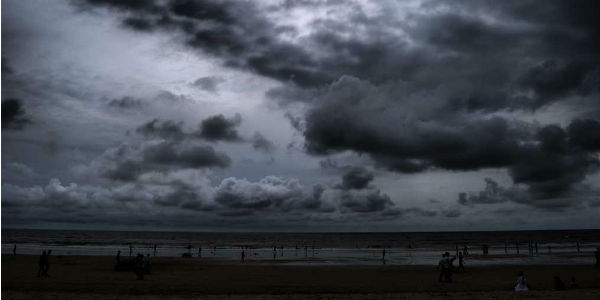
Updated on May 17, 2018 4:31 PM (IST): Curtains down for La Niña, ENSO neutral conditions begin
La Niña conditions have finally come to an end, paving way for ENSO neutral conditions. Equatorial Sea Surface Temperatures (SST) are near to below average across the East Central and Eastern Pacific.
During the last week, Nino indices have recorded a slight increase, especially Nino 3.4 that is a deciding factor for declaring El Niño, La Niña or neutral conditions.

These ENSO neutral conditions are favoured through September-November 2018, with the possibility of El Niño by Winter 2018-19.
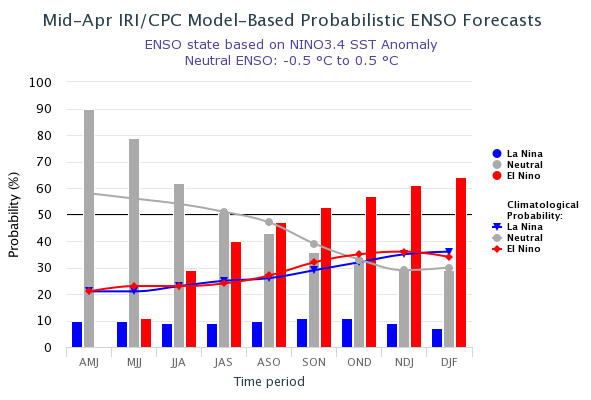
Like El Niño, there are three stages of La Niña as well that are explained below:
La Niña Watch: The Climate Prediction Center (CPC) issues a bulletin indicating conditions favourable for development of La Niña with a notice period of six months.
La Niña Advisory: It is issued when La Niña is observed and expected to continue.
Final La Niña Advisory: This is issued when La Niña conditions have ended.
Updated on May 3, 2018 4:31 PM (IST): ENSO neutral conditions likely before Monsoon
Following the pattern of past several weeks, weak La Niña conditions continued to prevail as entire Pacific Ocean has been showing a warming trend. In the past one week, the sea surface temperatures (SSTs) have witnessed a significant rise.
In fact, the Nino 3.4 index, which is primarily linked with the Indian Monsoon, has shown a substantial variation to the tune of 0.2°C. In fact, it is now seen at the value of 0°C on May 3 and is most likely to move towards the positive values in the coming week.
It has been the fifth consecutive week, wherein the temperatures have shown the rising trend. Here’s a look at the recent Nino Index (in °C):

According to Skymet Weather, most of the weather models are indicating that the indices would continue with the rising trend. In fact, there are strong indications that ENSO neutral conditions are likely to make way before the onset of Monsoon i.e. by May.
These neutral conditions are most likely to continue throughout the Monsoon and hence, it would not have any adverse impact over the performance of Southwest Monsoon 2018.

Image courtesy: iri.columbia.edu
Updated on April 25, 2018 5:31 PM (IST): La Niña declared, neutral conditions before Monsoon
After closely monitoring the sea surface temperatures (SST), La Niña was finally declared. The criteria of all the four seasons - of three months each – during which the La Niña has to maintain below SST has been met.
The Oceanic Nino Index (ONI), which is three months running mean of SST anomaly in the Nino 3.4 region, is based on SST departures from average and La Niña is declared when ONI is lower than or equal to 0.5°C for overlapping 3 months for five consecutive episodes. The most recent ONI value DJF (January – March 2018) is -0.8°C.
Following is the ONI values for last five episodes ever since the La Niña watch has been issued.

In the past one week, the sea surface temperatures (SSTs) have witnessed a rise. In past one week, the Nino 3.4 index, which is linked with the Indian Monsoon, has shown a marginal variation to the tune of 2°C. Although it continues to settle in negative but has shown slight increase and is seen at the value of -0.2°C on April 23.
It has been the fourth consecutive week, wherein the temperatures have shown the rising trend. Here’s a look at the recent Nino Index (in °C):
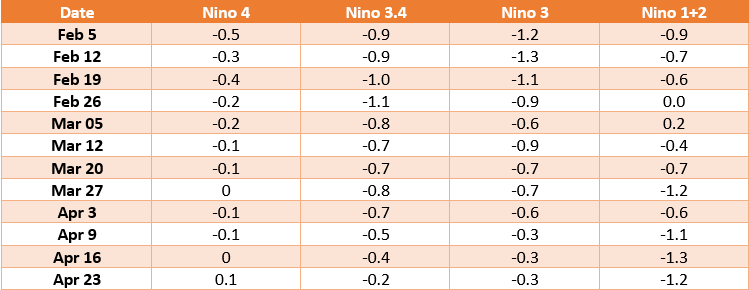
Further, weather models are indicating that temperatures would continue to increase in the coming days. With this, we expect gradual transition of La Niña conditions to the ENSO neutral conditions before the onset of Monsoon by May. Most of the statistical and dynamical models are in agreement over this.
However, the rising trend of Nino 3.4 would continue and there are elevated chances of El Niño by the fall/winter 2018.
Updated on March 28, 2018 10:41 AM (IST): Weak La Niña conditions to turn neutral by May
Weak La Niña conditions persists as the sea surface temperatures (SSTs) continues to be below average across the central and eastern Pacific Ocean.
Nino 3.4 which primarily decides the onset of La Niña or El Niño has witnessed marginal change in the last week as the recent value stood at -0.8°C. Although there was a drop of 0.1°C but such drop is considered to be normal.
Here’s a look at the recent Nino Index (in °C):

According to weathermen at Skymet Weather, despite below average temperatures, we can expect transition from La Niña to neutral most likely between March-May.
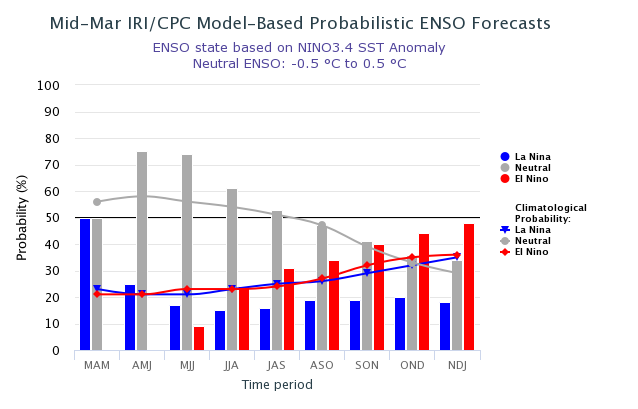
Weather models are indicating that these neutral conditions are likely to continue through the second half of the year. The following table shows the forecast probabilities for the same.

With this, Skymet Weather would once again reiterate that there are no alarming pointers that may impact the approaching Southwest Monsoon 2018.
Image Credit: iri.columbia.edu
Updated on March 20, 2018 5:41 PM (IST): Weak La Niña conditions persist, no alarming indication for Monsoon 2018
In the past week, there were only marginal changes in the indexes of Pacific Ocean. With this, weak La Niña conditions continue to persist.
With this, Skymet Weather would once again reiterate that we can expect gradual return from La Niña conditions to the neutral conditions from March to May.
Most importantly, the Nino 3.4 index, which is linked with the Indian Monsoon, does not give any alarming pointers or anxious moments that good have some impact on the approaching Southwest Monsoon 2018. Here’s a look at the recent Nino Index (in °C):

The warming of the Pacific Ocean continues, especially in the West Pacific as Sea Surface Temperatures (SST) continue to be above normal. However, East and Central Pacific are still cold as SSTs are settling below normal.
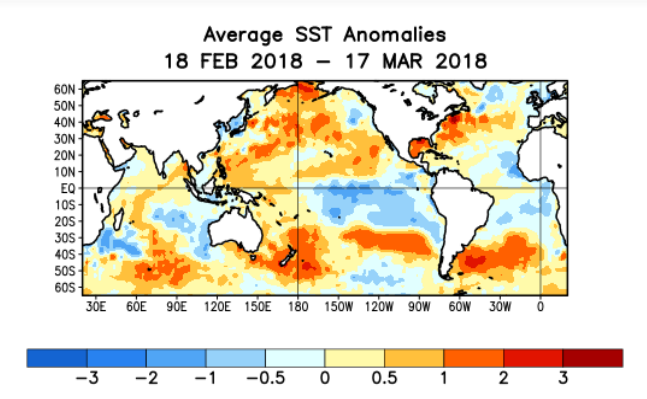
Image Credit: http://www.cpc.ncep.noaa.gov
Updated on March 14, 2018 1:41 PM (IST): Weak La Niña conditions continue, neutral conditions by onset of Monsoon 2018
In past one week, the Nino 3.4 index, which is linked with the Indian Monsoon, has shown a marginal variation to the tune of -0.1°C. Although it continues to settle in negative but has shown slight increase and is seen at the value of -0.7°C on March 12.
[yuzo_related]
It has been the third consecutive week, wherein the temperatures have shown the rising trend, indicating towards weak La Niña conditions.
However, Nino 3 and Nino 1+2 have registered drop in temperatures by 2°C-4°C. Here’s a look at the recent Nino Index (in °C):

As the warming of the Pacific Ocean continues, we expect gradual return from La Niña conditions to the neutral conditions from March to May. Most of the statistical and dynamical models are in agreement over this.
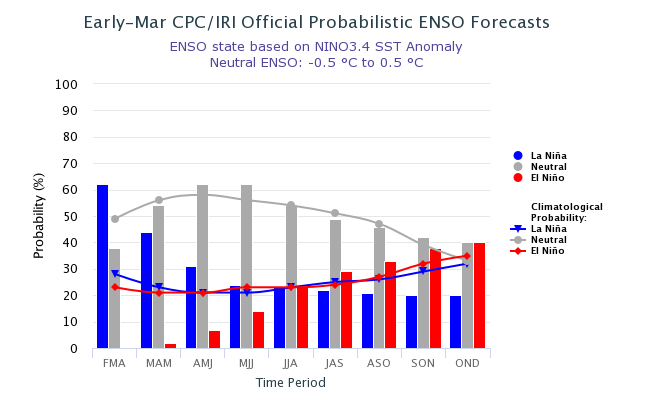
Graph Sources: https://iri.columbia.edu/
Most importantly, we expect these neutral conditions to return by the time Southwest Monsoon 2018 makes an onset over Indian subcontinent.
Updated on March 7, 2018 1:41 PM (IST): La Niña on rise, may taper down prior to onset of Southwest Monsoon 2018 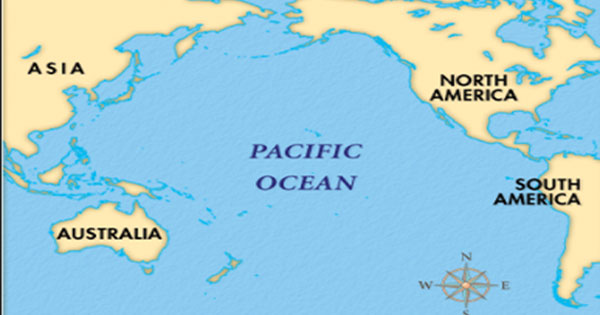 Both El Niño and La Niña are a much-debated topic, especially in Indian region as they have great bearing on Indian Monsoon. Both the weather phenomena have a different impact on Southwest Monsoon. While El Niño holds the power to corrupt Monsoon in India even in the evolving phase, La Niña is related to normal or above normal rainfall. With Monsoon 2018 round the corner, the time has come for us to have a reality check. The Pacific Ocean has strong linkages with Southwest Monsoon. During the last four weeks, equatorial sea surface temperatures (SST) were above average in parts of Western Pacific. Meanwhile, SSTs were below average over most parts of Central and East Pacific Ocean. This season, La Niña watch has already been issued, with meteorologists around the world closely tracking the same. However, there is still one season - of three months each - to go in which the La Niña has to maintain below sea surface temperatures (SST).
Both El Niño and La Niña are a much-debated topic, especially in Indian region as they have great bearing on Indian Monsoon. Both the weather phenomena have a different impact on Southwest Monsoon. While El Niño holds the power to corrupt Monsoon in India even in the evolving phase, La Niña is related to normal or above normal rainfall. With Monsoon 2018 round the corner, the time has come for us to have a reality check. The Pacific Ocean has strong linkages with Southwest Monsoon. During the last four weeks, equatorial sea surface temperatures (SST) were above average in parts of Western Pacific. Meanwhile, SSTs were below average over most parts of Central and East Pacific Ocean. This season, La Niña watch has already been issued, with meteorologists around the world closely tracking the same. However, there is still one season - of three months each - to go in which the La Niña has to maintain below sea surface temperatures (SST).
The Oceanic Nino Index (ONI), which is three months running mean of SST anomaly in the Nino 3.4 region, is based on SST departures from average and La Niña is declared when ONI is lower than or equal to 0.5°C for overlapping 3 months for five consecutive episodes. The most recent ONI value DJF (December – February 2018) is -0.9°C.
Following is the ONI values for last four episodes ever since the La Niña watch has been issued.

As shown in the table, the four episodes of ONI has recorded temperature below 0.5°C. The fifth episode is most likely to follow the same path and thus, indicating towards La Niña.
The Niño 3.4 index, which is linked with the Indian Monsoon, has been settling in negative. It was last seen at the value of -0.8 on March 5. Here’s a look at the recent Nino Index (in °C):

As per the above figure, Nino 1+2 has been showing increasing trend for the last two weeks. Meanwhile, Nino 3.4 has been settling below normal average by 1°C for last one month. But with the commencement of March, Nino 3.4 has registered some increase.
According to meteorologists, this is for the first time in the season that Nino 3.4 has shown an increase. Going further, these values will possibly continue to show a rising trend. In fact, weather models are indicating the transition of La Niña to neutral conditions is most likely during Northern Hemisphere spring i.e. from March to May, before the onset of Southwest Monsoon 2018 over the Indian subcontinent. The values between -0.5°C to 0.5°C are considered to be neutral conditions.
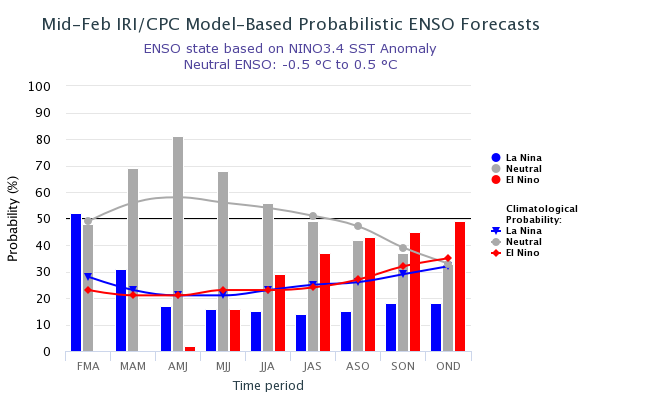
Image courtesy: NOAA/ Britannica Kids
Any information taken from here should be credited to skymetweather.com



